Miantenance
An In-Depth Guide to Cleaning and Maintaining Metal Wall Art Pieces
Metal wall decor has taken the interior design world by storm, with sales skyrocketing an impressive 200% over the past five years. These eye-catching pieces, crafted from metals like aluminum, copper, steel, and brass, add character, texture, and artistic flair to any space.
But how do you ensure your stunning masterpiece retains its vibrant colors and sophisticated shine for years? The secret lies in proper cleaning and maintenance.
This comprehensive guide discusses the best practices for preserving the timeless allure of decorative metal pieces. From understanding the unique needs of different metal types to implementing safe cleaning techniques and protecting against environmental factors like moisture and humidity, we’ve got you covered.
Neglecting proper care can cause tarnish, oxidation, discoloration, and permanent damage, diminishing your artwork’s visual impact and value. But with the right approach, you can safeguard your investment, extend its lifespan, and maintain those gorgeous colors and finishes that initially captivated you. Read on for details.
The Importance of Proper Metal Wall Art Maintenance
Investing in metal wall art is a financial commitment reflecting your style and taste. These unique pieces are designed to captivate and enhance the ambiance of your living spaces. However, maintaining their beauty and integrity requires a deliberate and ongoing effort.
Neglecting proper care can quickly diminish the visual appeal and longevity of your beloved metal wall art.
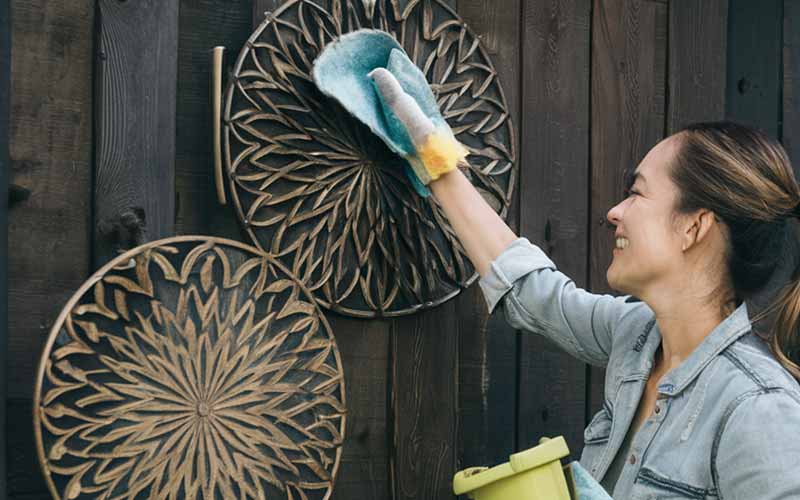
Protecting Your Investment
Metal wall art is a significant investment, often crafted by skilled artisans using high-quality materials. Proper maintenance protects your financial outlay, allowing you to enjoy the piece for years without costly repairs or replacements.
By taking proactive steps to clean and care for your metal art, you safeguard your investment and maximize its potential lifespan.
Extending the Lifespan of Your Artwork
Like any valuable possession, metal wall art is susceptible to the effects of time, environmental factors, and general wear and tear.
If left unchecked, tarnish, oxidation, and discoloration can gradually degrade the piece’s appearance and structural integrity.
Implementing a consistent maintenance routine can significantly extend the lifespan of your metal art, ensuring it remains a treasured part of your home for generations.
Maintaining Vibrant Colors and Finishes
One of the most captivating aspects of metal wall art is the intricate details, vibrant colors, and exquisite finishes that bring the piece to life. However, these elements can fade, dull, or become compromised if not correctly cared for.
Regular cleaning and applying appropriate protective coatings can help preserve the original vibrancy and luster, allowing you to appreciate the artwork’s true beauty for years.
Neglecting proper maintenance can have severe consequences, leading to irreversible damage, loss of value, and premature degradation of your cherished metal wall art.
By prioritizing care and upkeep, you will protect your investment and ensure that these magnificent pieces continue to inspire and captivate for generations.
Understanding Different Types of Metal Wall Art
Before delving into cleaning techniques, it’s crucial to identify the specific type of metal your wall art is made from. Different metals react differently to various cleaning methods, and using the wrong approach can cause irreparable damage.
Raw or Unfinished Metals
Raw or unfinished metals, such as steel, iron, copper, aluminum, and bronze, are often left naturally without protective coatings.
While these metals can develop a beautiful patina over time, they are also susceptible to tarnish, oxidation, and discoloration if not adequately cared for.
Painted or Powder-Coated Metals
Many metal wall art pieces feature a painted or powder-coated finish, ranging from vibrant colors to sleek metallic hues.
These finishes provide additional protection against environmental factors but can also be prone to chipping, fading, or discoloration if not cleaned and maintained correctly.
Polished or Brushed Finishes
Polished or brushed finishes are commonly found on metal wall art pieces, adding a sleek and refined touch. These finishes can be more delicate and susceptible to scratches, making gentle cleaning methods essential to preserve their luster.
Regular Cleaning and Dusting Techniques
Regardless of the metal type or finish, consistent cleaning and dusting are essential for preserving the pristine appearance of your metal wall art.
Even the slightest accumulation of dirt, dust, or grime can gradually diminish your piece’s visual impact and potentially lead to more severe issues like tarnish or discoloration if left unaddressed. Implement these recommended techniques to keep your pieces looking their best.
Gently Removing Light Smudges or Fingerprints
Reach for a high-quality microfiber cloth dampened with clean water for light smudges or fingerprints.
Gently wipe the affected area, using circular motions and minimal pressure to avoid scratching the metal’s surface. The microfiber’s soft fibers lift and capture any light soiling without causing damage.
After wiping, promptly dry the area with a dry microfiber cloth to prevent water spots or moisture buildup, which can accelerate tarnishing or oxidation processes.
Soft Cloths and Microfiber Dusters
Invest in high-quality microfiber cloths and dusters designed explicitly for delicate surfaces for regular dusting and light cleaning. These materials are gentle yet effective, capturing dust and dirt particles without scratching or damaging the metal’s finish.
When dusting, use a light touch and avoid excessive pressure, which can leave visible marks or abrasions. Also, regularly wash or replace your cleaning cloths to prevent the transfer of dirt and oils from previous use.
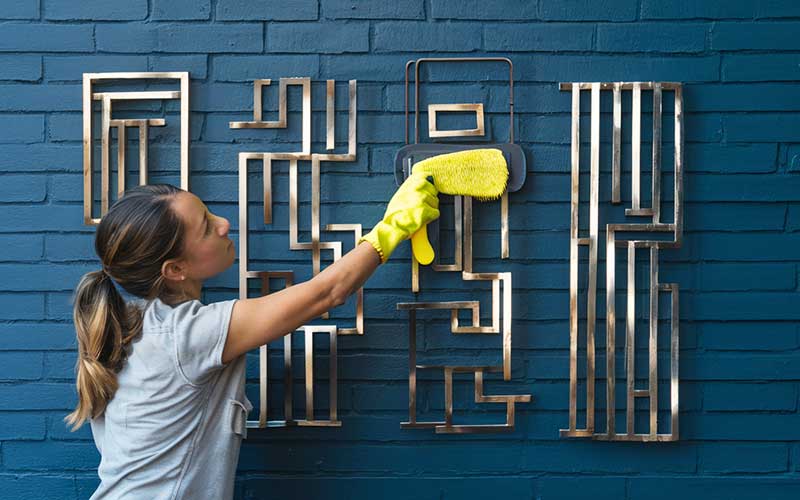
Using Natural DIY Cleaning Solutions
Consider using natural cleaning solutions like lukewarm water and mild dish soap for stubborn dirt or grime buildup. Adding a gentle soap can help break down and lift stuck-on debris without the harsh chemicals found in some commercial cleaners.
Mix a few drops of mild dish soap with lukewarm water in a clean spray bottle or bowl to create your cleaning solution. Dampen a microfiber cloth with the solution and gently wipe down the affected areas, not oversaturating the metal’s surface.
After cleaning, thoroughly rinse the area with clean water and dry it with a fresh, lint-free cloth to remove any soap residue, possibly leading to streaking or discoloration if left behind.
Avoiding Abrasives and Harsh Chemicals
Avoid abrasive cleaners, harsh chemicals, and scrubbing pads, as these can easily scratch, dull, or discolor the metal’s surface. Even seemingly harmless household cleaners may contain ingredients that can react adversely with certain metals, leading to irreversible damage.
Instead, opt for gentle, pH-neutral cleaning solutions formulated for the metal you’re working with. These specialized products effectively remove grime without compromising the material’s integrity.
Frequency of Cleaning Based on Environment
The frequency of cleaning will depend on the environment where your metal wall art is displayed. Pieces in high-traffic areas, such as kitchens or environments with increased dust and humidity, may require more frequent cleaning than those in low-traffic spaces like bedrooms or formal living areas.
As a general guideline, aim to dust your metal wall art weekly or bi-weekly, depending on the exposure to airborne particles.
Follow the manufacturer’s recommendations or consult a professional art restoration specialist to determine an appropriate cleaning schedule based on your specific pieces and environment for deeper cleaning.
Implementing these regular cleaning and dusting techniques can maintain the pristine appearance of your metal wall art while minimizing the risk of long-term damage.
Remember, consistency and a gentle touch are essential—a little effort goes a long way in preserving the beauty and longevity of your investment.
Dealing with Tarnish, Oxidation, Discoloration, and Grime
Even with regular cleaning, metal wall art pieces may succumb to the effects of tarnish, oxidation, discoloration, and grime buildup over time.
These issues can significantly diminish the visual appeal of your artwork, obscuring intricate details and dulling once-vibrant finishes. Understanding the causes and implementing safe cleaning methods are crucial for restoring your metal wall art’s original beauty.
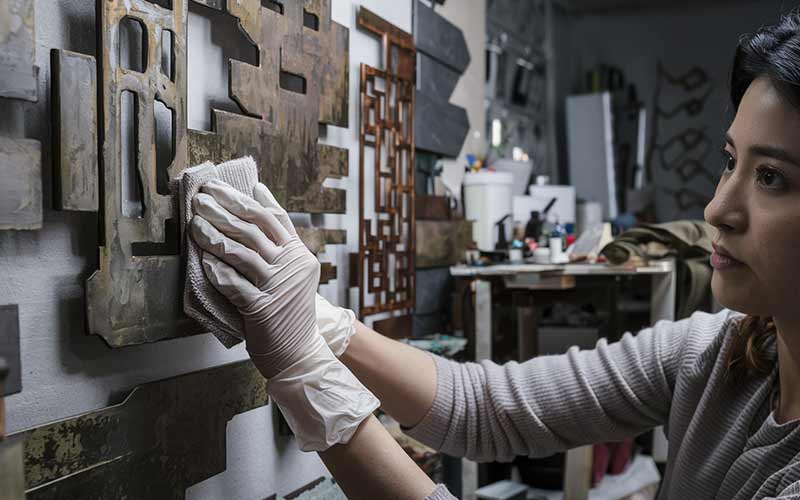
Causes of Tarnish, Oxidation, and Discoloration
Tarnish and oxidation are natural processes when metals react with environmental factors such as moisture, sulfur, and oxygen.
Copper is particularly prone to tarnishing, while iron and steel are susceptible to oxidation (rust). Discoloration can also arise from UV light, chemicals, or heat exposure.
Grime, on the other hand, refers to the accumulation of dirt, grease, and other contaminants on a metal’s surface. This buildup can obscure the metal’s natural luster and accelerate tarnishing and oxidation.
Safe Cleaning Methods for Various Metals
Different metals require specific cleaning methods to effectively remove tarnish, oxidation, discoloration, and grime without causing further damage. Here are some safe options:
Aluminum:
- For light tarnish or grime, mix cream of tartar with lemon juice or vinegar to create a paste. Gently rub the paste onto the affected areas, let it sit for a few minutes, and rinse thoroughly.
- Make a baking soda paste with water for stubborn stains and gently scrub onto the surface using a soft-bristled brush or cloth.
Copper and Brass:
- Create a paste using equal parts salt, vinegar, and flour. Gently rub the paste onto the tarnished or grimy areas with a soft cloth, sit for a few minutes, then rinse thoroughly with clean water.
- Lemon juice or ketchup can also effectively remove tarnish and grime. Apply, let sit, and rinse as directed.
Steel and Cast/Wrought Iron:
- For light surface rust or discoloration, make a baking soda paste with water and gently scrub onto the affected areas using a soft-bristled brush or steel wool.
- Soak the piece in white vinegar overnight for more stubborn rust or grime, then scrub with steel wool or a wire brush.
Stainless Steel:
- Use a mild soap and water solution or a dedicated stainless steel cleaner for general cleaning and grime removal.
- For tarnish or discoloration, apply a paste with baking soda and water to the affected areas, let it sit for a few minutes, then rinse thoroughly.
To help you avoid potential damage, here’s a table highlighting what to avoid when cleaning various metals:
| Metal | Avoid |
| Aluminum | Steel wool, abrasive cleaners, acidic cleaners (except diluted lemon juice or vinegar) |
| Copper & Brass | Abrasive cleaners, chlorine-based cleaners, ammonia |
| Steel & Cast/Wrought Iron | Harsh chemicals, acidic cleaners (except diluted vinegar) |
| Stainless Steel | Abrasive cleaners, chlorine-based cleaners, steel wool (can cause scratches) |
Restoring Shine and Luster
After removing tarnish, oxidation, discoloration, and grime, you should restore the metal’s original shine and luster. Here are some safe options:
Use a high-quality metal polish designed for the type of metal you’re working with for polished finishes.
Apply a small amount to a soft cloth and buff the surface in gentle, circular motions. Avoid using metal polishes on brushed or matte finishes, as they can alter the desired texture.
For brushed or matte finishes, skip the polish and clean the surface with gentle, pH-neutral soap and warm water. Then, follow up with a thorough drying using a clean, lint-free cloth. This approach will help maintain the desired finish while removing residual grime or discoloration.
Always work in small sections when restoring shine and luster, and follow the manufacturer’s instructions carefully.
Before using any cleaning products or polishes, test them on an inconspicuous area to ensure they won’t cause discoloration or damage.
Implementing these safe cleaning methods and following the guidelines for restoring shine and luster can effectively combat tarnish, oxidation, discoloration, and grime, preserving the timeless beauty of your metal wall art for years to come.
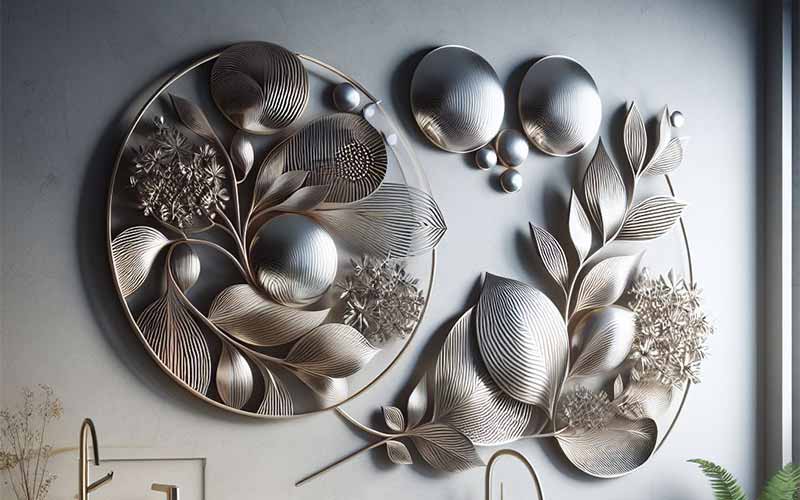
Protecting Metal Wall Art from Moisture and Humidity
Moisture and humidity are two of the biggest enemies of preserving the integrity and beauty of metal wall art.
If left unchecked, prolonged exposure can lead to tarnish, oxidation, and even structural damage. Therefore, it is crucial to implement proactive measures to control moisture and humidity levels to safeguard your investment.
Risks of Moisture Damage
Moisture can cause metal to rust, leading to unsightly discoloration, pitting, and potentially compromising the piece’s structural integrity. High humidity levels can also accelerate tarnishing, particularly for reactive metals like copper. Even temporary exposure to moisture can initiate these damaging effects, making it essential to maintain a dry environment for your metal wall art.
Tips for Controlling Humidity Levels
To minimize the risk of moisture damage, consider investing in a dehumidifier or using silica gel packs in the area where your metal wall art is displayed. Aim to maintain humidity between 30% and 50% for optimal preservation. Monitor humidity levels regularly and adjust to ensure a consistent, safe range.
Additionally, proper ventilation can help regulate humidity levels. Ensure adequate air circulation in the room or space where your metal wall art is displayed, and consider using fans or opening windows during drier periods to promote airflow.
Using Protective Coatings or Sealants
Certain types of metal wall decor can benefit from a clear protective coating or sealant that provides an additional barrier against moisture and environmental factors.
However, using products formulated for the metal type and finish is essential, as improper application can lead to discoloration or damage.
Consult a professional art restoration specialist or refer to the manufacturer’s recommendations to determine your pieces’ most suitable protective coating or sealant.
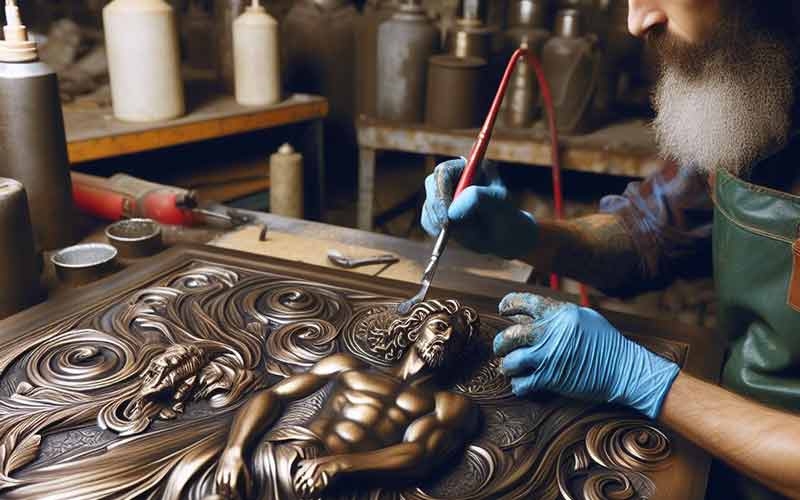
Temperature and Humidity Control
Fluctuations in temperature and humidity can accelerate the tarnishing process for many metals, particularly those prone to oxidation, like copper. To minimize these risks, maintain consistent temperature and humidity levels where your metal wall art is displayed.
Use climate control systems, such as air conditioning or dehumidifiers, to regulate the environment and prevent sudden changes in temperature or humidity. Avoid placing metal wall art near sources of heat or moisture, such as radiators, fireplaces, or bathrooms, as these can create localized areas of high humidity or temperature fluctuations.
By prioritizing moisture and humidity control, you can significantly reduce the likelihood of tarnish, oxidation, and other damage to your cherished decorative metal wall pieces.
Remember, prevention is vital. Taking proactive steps to maintain a stable, dry environment will pay dividends in preserving the beauty and longevity of your investment.
Handling and Storing Metal Wall Art
Proper handling and storage techniques are crucial to prevent accidental scratches, dents, or other physical damage to metal wall art. Even minor mishandling can compromise these delicate artworks’ integrity and visual appeal.
Exercising care and implementing best practices ensures that your metal wall art will remain in good condition for years.
Further Reading:
Proper Techniques for Moving and Transporting
Always handle it carefully and carefully when moving or transporting metal wall art. Wear clean gloves to avoid transferring oils or contaminants from your hands onto the surface, which can lead to discoloration or tarnishing over time. For larger pieces, enlist the help of an assistant to ensure safe and controlled movement.
Wrap each piece individually in acid-free paper or cloth to protect it from scratches, dents, or other physical damage during transit. Avoid stacking or placing different objects on the wrapped artwork, which could cause deformation or leave permanent impressions.
When transporting metal wall art, ensure it is secure and unable to shift or move within the vehicle. Use appropriate padding or cushioning to prevent any jarring or impact during the journey.
Storing Pieces When Not in Use
If you need to temporarily store your metal wall art, choose a cool, dry, and well-ventilated area with consistent temperature and humidity.
Fluctuations in these conditions can accelerate tarnishing and oxidation processes, potentially damaging your artwork.
Wrap each piece individually in acid-free paper or cloth to protect it from scratches, dust accumulation, or environmental factors that may cause tarnishing or discoloration.
Avoid using plastic wrap or materials that can trap moisture, as this can lead to condensation and corrosion.
If storing multiple pieces, separate them with acid-free paper or cloth to prevent direct contact and potential scratching or abrasion.
Consider using archival storage boxes or containers designed specifically for art storage to provide additional protection.
Avoiding Scratches and Dents
Be mindful of the environment where your metal wall art is displayed. Avoid hanging pieces in high-traffic areas or near areas where they may be accidentally bumped or scratched.
Consider using wall-mounted protective cases or frames for delicate pieces to minimize the risk of physical damage.
When cleaning or handling metal wall art, exercise caution and avoid using abrasive materials or tools that could potentially scratch or dent the surface.
Refer to the manufacturer’s recommendations or consult a professional art restoration specialist for safe handling and cleaning techniques specific to your pieces.
Professional Cleaning and Restoration Services
While many cleaning and maintenance tasks can be handled at home, there may be instances where seeking professional help is advisable.
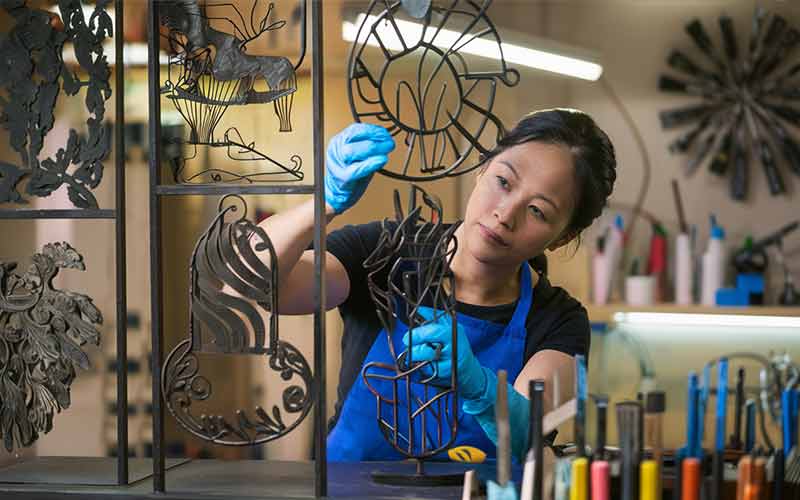
When to Seek Professional Help
If your metal wall art is precious, rare, or intricately detailed, you should consult a professional art restoration specialist for proper cleaning and maintenance.
Professionals have the expertise and specialized equipment to handle delicate pieces safely and effectively.
Finding Reputable Art Restoration Specialists
Look for reputable art restoration specialists working with metal art pieces. Check their credentials, experience, and customer reviews to ensure a proven track record of delivering high-quality results.
Cost Considerations
Professional cleaning and restoration services can be costly, depending on the work’s complexity and the piece’s rarity. However, for valuable or sentimental metal wall art, the investment in professional care can be well worth it to preserve the artwork’s integrity and value.
Following these comprehensive guidelines, you can ensure your metal wall art pieces remain a stunning and cherished addition to your space for many years.
Regular cleaning, proper handling, and mindful maintenance will protect your investment and fully allow you to appreciate these unique artworks’ beauty and craftsmanship.

